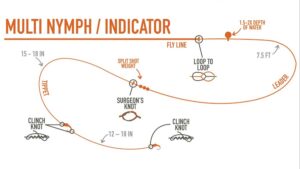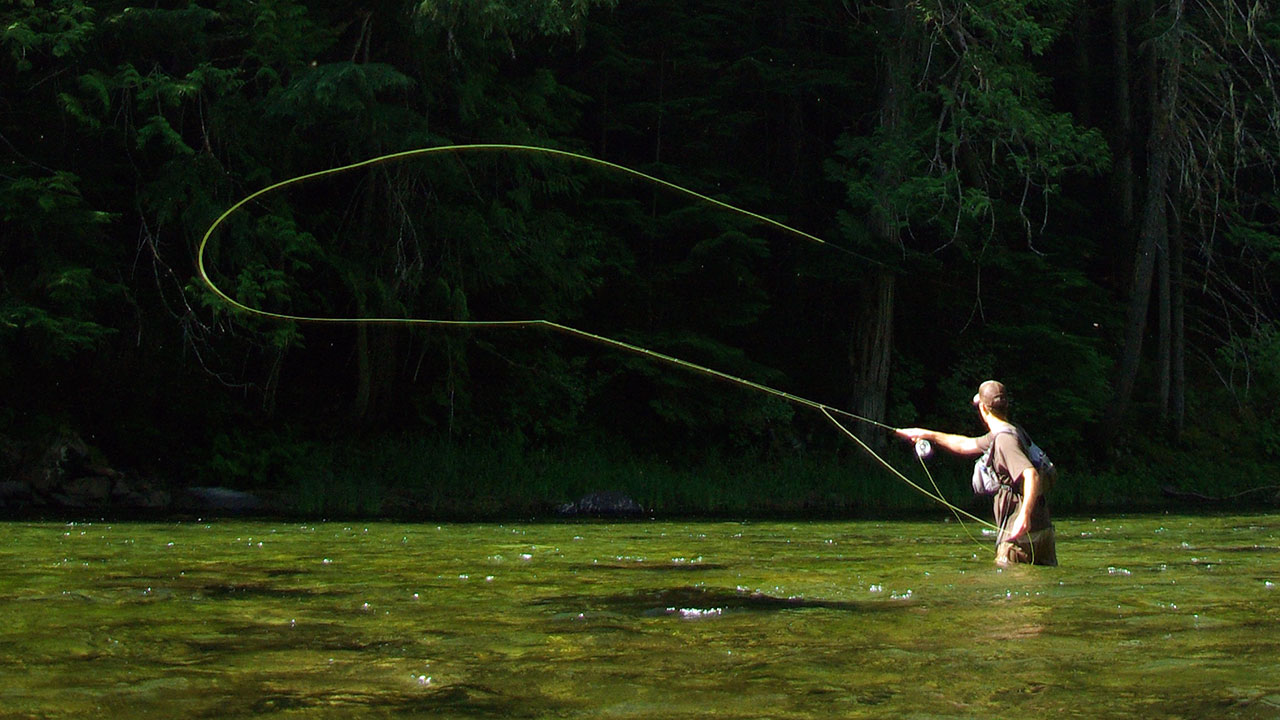Today, we’re diving into the fascinating world of nymphing: comparing the tried-and-true standard nymphing method with the increasingly popular Euro nymphing technique. Both have their unique strengths, and knowing the differences can help you decide which method to use on your next fishing adventure. Plus, I’ll share three popular fly patterns for each type to get you started. Let’s get to it!
What is Standard Nymphing?
Standard nymphing, also known as traditional or indicator nymphing, is a classic method that many of us grew up with. It typically involves using a strike indicator (essentially a small float) to detect bites. The indicator helps you keep track of your fly’s depth and drift, making it easier to detect subtle takes from fish.
Key Features:
- Strike Indicator: Acts as a visual cue for bites and helps maintain the correct depth.
- Split Shot: Added to the leader to help sink the fly to the desired depth.
- Longer Leader: Usually 9-12 feet, allowing for a natural drift.
Detecting Bites: In standard nymphing, the strike indicator is your best friend. It floats on the surface and will either dip, pause, or move unnaturally when a fish takes your fly. Keeping a close eye on the indicator is crucial for timely hook sets.
Knots Used:
- Improved Clinch Knot: For tying your fly to the tippet.
- Double Surgeon’s Knot: For connecting tippet to leader.
- Blood Knot: Another option for connecting tippet to leader.
Popular Fly Patterns for Standard Nymphing
Pheasant Tail Nymph: This is a versatile and effective pattern that mimics many types of aquatic insects. Its natural colors and slender profile make it a go-to fly in many situations.
Hare’s Ear Nymph: The Hare’s Ear is another classic pattern that works well in a variety of conditions. Its buggy appearance and ability to imitate a range of nymphs make it a must-have in your fly box.
Prince Nymph: Known for its peacock herl body and white biot wings, the Prince Nymph is great for attracting fish in murky water. Its added flash can be particularly effective during runoff season.
What is Euro Nymphing?
Euro nymphing, also known as Czech, French, or Spanish nymphing depending on the specific style, is a technique that originated in Europe and has gained popularity worldwide. This method eliminates the strike indicator and focuses on maintaining direct contact with the flies, allowing for increased sensitivity and control.

Key Features:
- Tight Line Technique: Direct connection to the flies, with no slack in the line.
- Thin, Long Leaders: Often 20 feet or more, made of thin material to reduce drag and improve sensitivity.
- Weighted Flies: Flies are typically weighted to get down quickly, eliminating the need for split shot.
Detecting Bites: In Euro nymphing, the key to detecting bites is maintaining a tight line and feeling for subtle changes. You can feel the tension and any slight tug directly through the line. Additionally, a colored sighter section of the leader can visually indicate strikes when it straightens, stops, or moves unexpectedly.
Knots Used:
- Tippet Ring: Connects the leader to the tippet and allows for easy tippet changes.
- Double Surgeon’s Knot: For connecting tippet to leader.
- Davy Knot: A simple and strong knot for tying flies to the tippet.
Popular Fly Patterns for Euro Nymphing
Perdigon Nymph: This slim, fast-sinking fly is designed to cut through the water quickly and get to the strike zone fast. Its smooth, streamlined body helps reduce drag and improve drift.
Frenchie: A variation of the Pheasant Tail, the Frenchie adds a hot spot of bright dubbing near the bead head. This added flash can be a game-changer in getting a fish’s attention.
Jig Nymph: Tied on a jig hook, these nymphs ride hook-point up, which reduces snagging on the bottom. They often have a tungsten bead for extra weight, making them ideal for getting deep quickly.
Choosing the Right Method
So, which method should you choose? It really depends on the conditions and your personal preference. Standard nymphing is great for covering water and detecting subtle takes, especially in slower, deeper pools. Euro nymphing excels in faster, pocket water where precise control and sensitivity are crucial.
Tips for Success:
- Experiment: Try both methods and see which one works best for you in different situations.
- Be Versatile: Keep a variety of fly patterns on hand to match the hatch and water conditions.
- Practice: Both techniques require practice to master. Spend time on the water refining your skills.
There you have it, friends – a friendly guide to the differences between standard nymphing and Euro nymphing, along with some top fly patterns and essential knots for each method. Whether you’re a traditionalist or looking to try something new, both techniques have a lot to offer. So grab your gear, head to the river, and give them a try. Tight lines and happy fishing!

